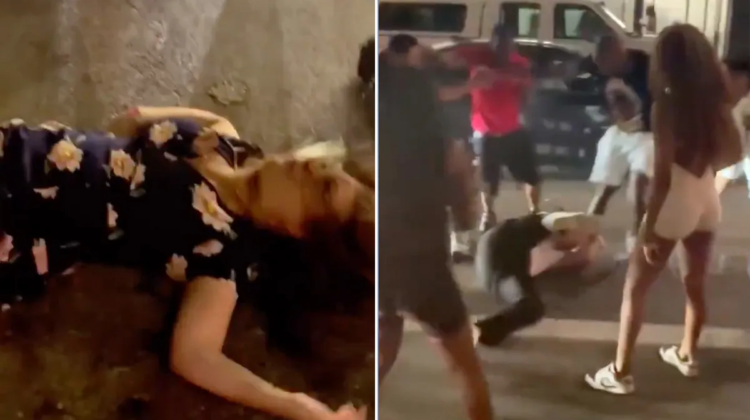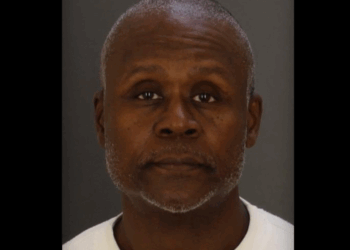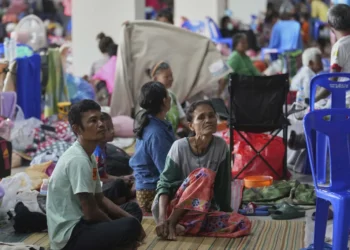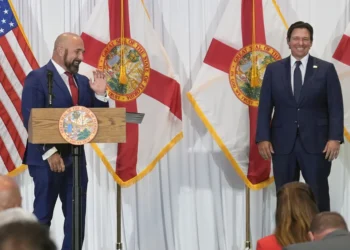
[Want even more content from FPM? Sign up for FPM+ to unlock exclusive series, virtual town-halls with our authors, and more—now for just $3.99/month. Click here to sign up.]
Last month a white high school student in South Carolina was brutally assaulted by three black teammates at a Fellowship of Christian Athletes football camp. The attack was captured on video and left the victim with a severe concussion and bruises, leaving him likely to miss his senior football season. His attackers accused him of posting a racial slur online; he denies that and there is no evidence to support it. Several students involved now face criminal charges, and the incident’s being investigated as racially motivated, which of course it was.
Also last month, a violent brawl (pictured above) occurred in downtown Cincinnati, some of which was captured in viral videos (of course it was, because no one intervenes to break up violence anymore; everyone either gangs up on the victim or stands around filming it so they can upload it to TikTok or Worldstar). The incident involved a predominantly black crowd attacking a white man and woman. The man was beaten and stomped on by the cowards, while the woman was knocked unconscious by a black man. Five individuals have been charged with assault, aggravated riot, and felonious assault.
It was shocking and clearly racially motivated, but a black Cincinnati Councilwoman named Victoria Parks posted on social media, “They begged for that beat down! I am grateful for the whole story.” She took some heat for that ugly comment but later doubled down on it, stating “I wrote what I wrote.”
These are just a couple of incidents of a phenomenon that is becoming impossible to ignore, although the mainstream, left-wing media pretend it does not exist, because it points an accusing finger at a longstanding reality that everyone with eyes to see is fully aware of, but which it is socially and politically forbidden to discuss. And that is, racism against white people.
Recently I was privileged to have Jeremy Carl as a guest on my Freedom Center podcast The Right Take with Mark Tapson. Carl, a senior fellow at the Claremont Institute and former Deputy Assistant Secretary of the Interior, is the author of a provocative, important book from 2024 that deserves wider conversation, precisely because its topic is so taboo. So in addition to discussing it with him on the podcast, I decided to review the book here at FrontPage Mag as well.
The Unprotected Class: How Anti-White Racism Is Tearing America Apart argues indisputably that anti-white racism has become an entrenched, systemic force in American institutions, contributing to societal division and, notably, to patterns of criminal violence, including black-on-white crime. Carl brings a meticulous yet accessible approach to a book that is both a diagnostic and a call to action, urging readers to confront a dangerous trajectory in race relations.
The Unprotected Class posits that anti-white racism, far from being a fringe phenomenon, is now a mainstream policy and cultural force in America. Carl argues that this is manifested in various arenas—education, law, media, and even religion—where whites are systematically disadvantaged or demonized. He contends that the civil rights movement, initially rooted in a quest for universal justice, has been co-opted into a framework that justifies discrimination against whites under the guise of equity. This shift, he writes, fosters resentment and division, with tangible consequences, including an increase in interracial violence, particularly black-on-white crime.
Carl’s book is structured to provide a comprehensive case, drawing on historical analysis, statistical data, and cultural critique. He examines phenomena like affirmative action, disparate impact laws, and media narratives, which he argues create a double standard that implicitly or explicitly targets whites. The book’s relevance to black-on-white criminal violence lies in its assertion that these policies and cultural shifts have emboldened certain behaviors and eroded protections for whites, leaving them vulnerable as an “unprotected class.”
A significant portion of the book addresses crime, with Carl arguing that media and institutional biases obscure the reality of black-on-white violence while amplifying narratives of white-on-black crime. He suggests that the selective reporting of crime—in which the race of perpetrators is often omitted if they are black but highlighted if they are white—creates a distorted public perception, contributing to a culture in which black-on-white violence is downplayed or excused, emboldening further criminality.
Carl cites FBI crime statistics to support his case, noting that in 2020, for example, black Americans, who comprise about 13% of the population, were responsible for a disproportionate share of violent crimes, including those against whites. He references data showing that black-on-white crimes occur at significantly higher rates than white-on-black crimes, with interracial homicide rates reflecting a stark asymmetry. For instance, in 2019, the FBI’s Uniform Crime Reports indicated that black offenders committed approximately 15% of homicides against white victims, while white-on-black homicides were less than 10% of the total, despite whites being a much larger demographic.
The book ties this to broader cultural phenomena, such as the aftermath of the George Floyd rioting in 2020. He argues that the vilification of law enforcement and the elevation of figures like “two-bit black criminal scumbag” Floyd have undermined law and order, particularly in urban areas. This, he claims, has led to a surge in violent crime, with whites often targeted due to racial animus fueled by anti-white rhetoric in media and academia.
Carl’s use of data is one of the book’s strengths, as he grounds his arguments in statistics from reputable sources like the FBI and Pew Research Center. His analysis of crime reporting patterns is particularly compelling, as he highlights cases where media outlets avoid mentioning the race of black perpetrators in interracial crimes, creating a narrative vacuum that he argues distorts public understanding. For example, he points to high-profile cases where black-on-white violence received minimal coverage compared to incidents fitting a “white supremacy” narrative.
The book’s relevance to the issue of black-on-white criminal violence lies in its attempt to break the taboo: openly discussing racial patterns in crime without fear of being labeled racist. He argues that this silence perpetuates harm, as it prevents honest policy discussions about crime prevention and victim protection. Carl advocates for reforms like eliminating affirmative action, revising civil rights laws to ensure equal treatment, and strengthening law enforcement to address what he sees as a crisis of unchecked violence.
What is the end game of this social and political phenomenon? Carl lays it out bluntly:
My central contention is that many of the fundamental trends I have outlined serve a common ideological purpose. That purpose is to create an intellectual and cultural environment to justify the expropriation of land, property, and other wealth from whites while instituting a permanent regime of anti-white employment and legal discrimination. If this sounds alarmist or implausible, let me assure you that it is already ongoing. In many cases it is still in the margins of our popular politics, but like so many other leftist political movements of the 20th and 21st centuries, what was marginal will soon become mainstream.
The race-mongering Left is always demanding that Americans have a national conversation about race, by which they mean they want to put their anti-white narrative at the forefront of our national consciousness for the purposes of extorting money and power. Jeremy Carl’s data-driven book The Unprotected Class is a bold, contentious, thought-provoking, and taboo-breaking contribution that succeeds in putting the facts at the forefront of that conversation, and challenging the race hustlers to confront an inconvenient truth.
Follow Mark Tapson at Culture Warrior
















